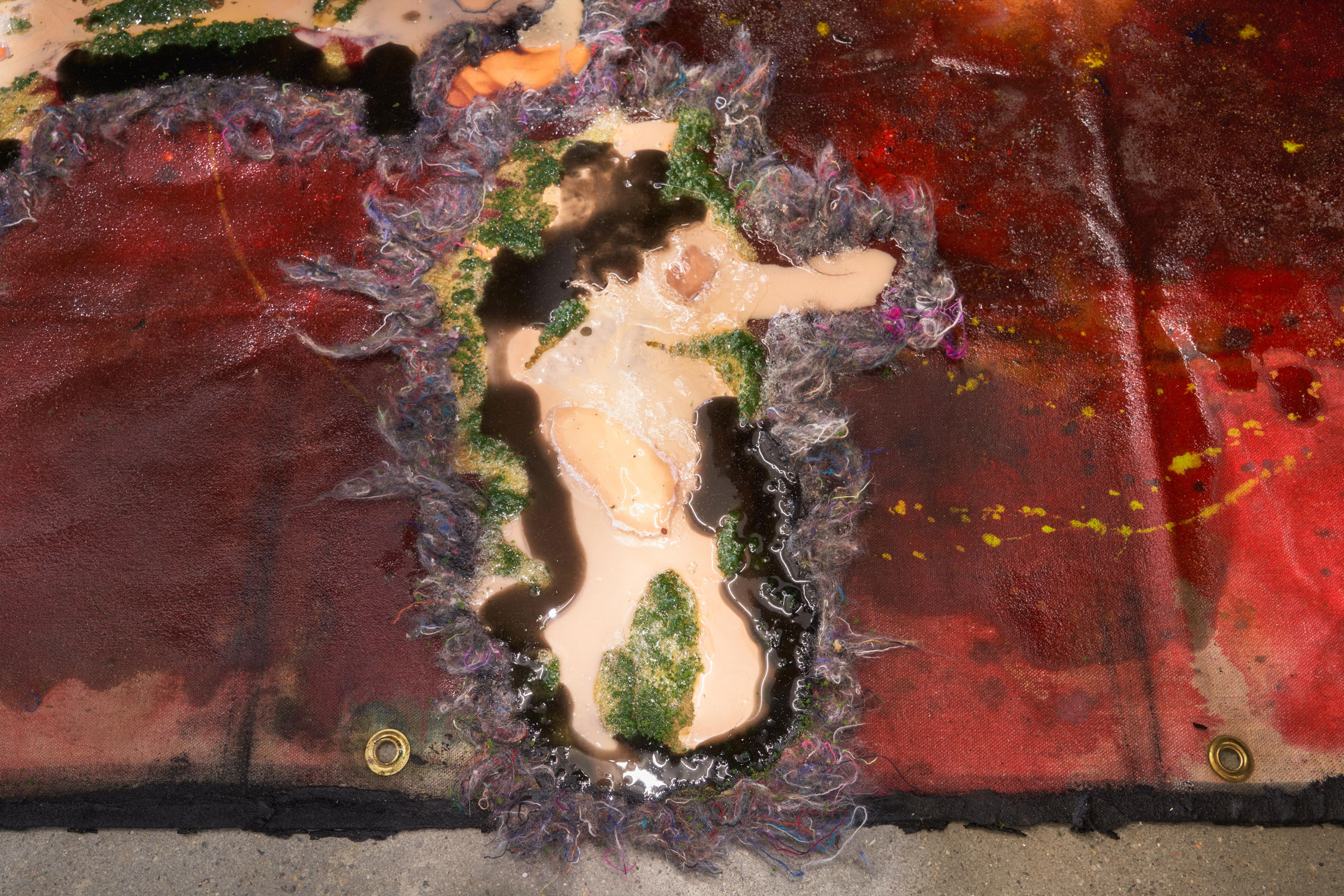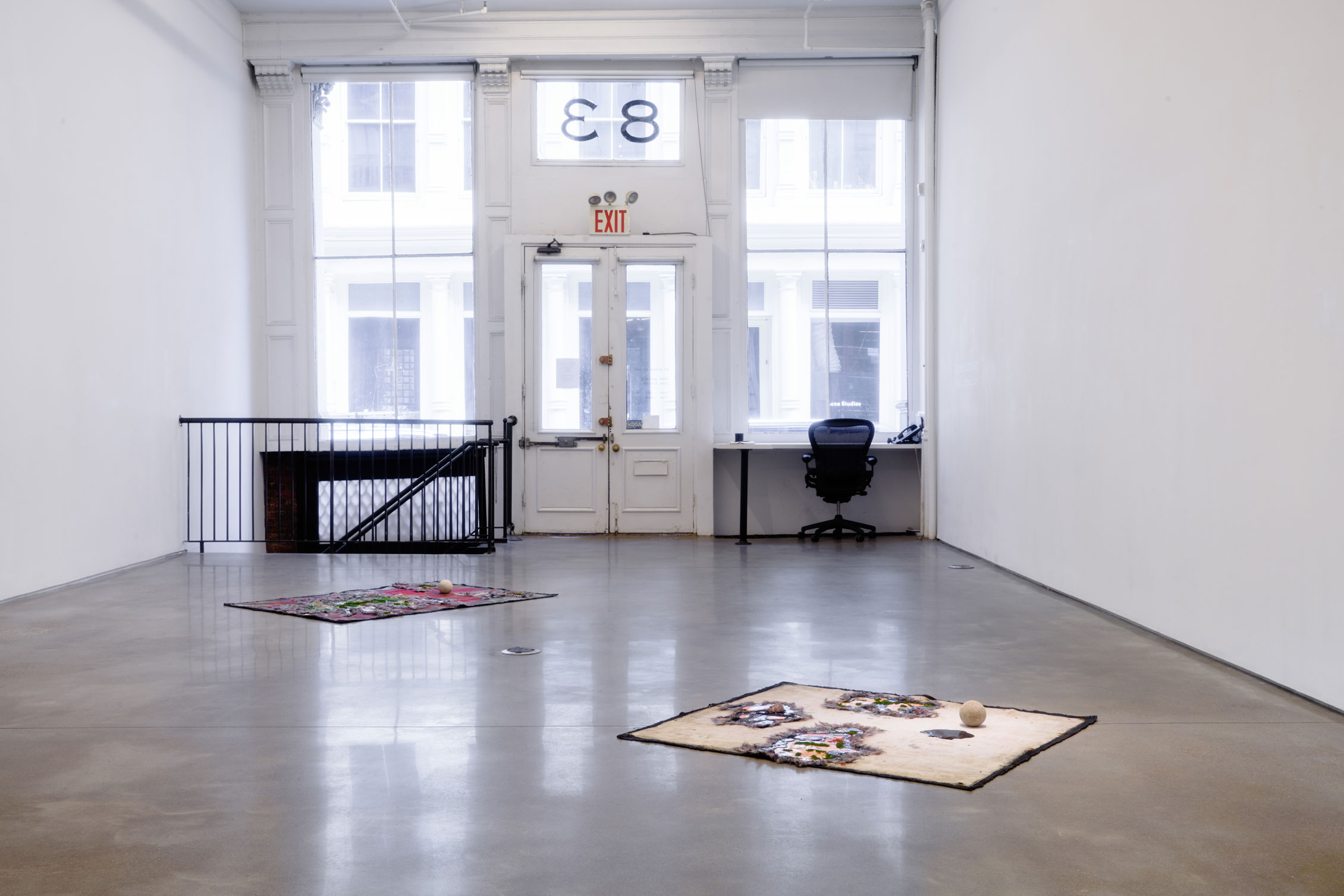
Held in place by gravity, three horizontal sculptures make up James Crosby’s solo exhibition "Sight Specific" at New York’s Team Gallery. A single concrete ballpins each mottled rectangle to the floor from above. Like mini terrains, one must look downwards into these works. There, a surprise jump in scale occurs over and over, whereby this surface suddenly shifts from vast terrain into vulnerable epidermis. Crosby’s work tends to be materially emphatic in this way, heavily textured and layered in a physical sense while being informed by researched historical focuses. Through this process he describes the relationship between bodies and the designs that surround and contain them, and in doing so elucidates the nature of these structures as themselves bodies reliant upon other bodies.
The base of each field is a vulcanized rubber ground cover. Crosby mimics the waterproof gum blankets that were issued to soldiers in the Union Army during the Civil War, offering protection from muddy soil, used as ponchos against falling rain, and even painted to become checkerboard game surfaces. At the time, gum blankets were advertised as a bonus to enlisting, and they were often stolen from the dead by Confederate soldiers, whose leaky linseed oil version paled in comparison. Crosby puts down layers on top of this. Thick cream canvas drop cloths mostly cover the rubber, sprouting miniature landscapes. Tiny green model trees and multicolored fibers protrude; the latter being picked apart strands of disaster blankets produced by UNICOR, a government-owned corporation that operates profitable prison labor industries across the US. The flatter zones are bruised with loose pigments and the pastel powders of snap-line utility chalk. Clear resin soaks through, glistening and mixing colors. Elsewhere, puddles form in solid black or a sickly peach-pink color named “Fleshtone” by the manufacturer, belying the material’s typical use as a stand-in for assumedly white skin. Read as flesh, the larger rectangle resembles a shirt drenched in blood and sweat, left to grow mold. Brought together, Crosby begins to render a direct material map to the violent processes of labor and enclosure upon bodies in the US over time, dating through the long history of slavery and colonization, to the Civil War, into today.

Rolled by hand, the concrete ball that sits atop each sculpture is a recollection of David Hammons’ Bliz-aard Ball Sale, in which the artist stood alongside sidewalk sellers on Canal Street hawking snowballs in the winter of 1983. Although deliberately ephemeral and ridiculous, Hammons’ gesture became iconic through a series of photographs that show him in front of a striped blanket covered in neat white rows of snowballs. Once melted, the action would’ve edged on rumor if these images didn’t exist. Attentive to the location of bodies in space, the city street was Hammons’ live environment. Crosby gives an inverse to this, collapsing spans of time and space into graspable landscapes about the same size as Hammons’ blanket. Crosby, like Hammons, enacts a conscious punning that remains potentially invisible to the one looking, seeking to contort the designation of meaning onto certain identifiers. With the concrete snow ball he solidifies Hammons’ gesture into a kind of punctuation mark and a literal weight. In another possible pun, a small clay mask sits additionally on one of the works (Cite 3); an object typically intended to confuse, transform, or disguise the wearer’s identity. Likewise, the triple-entendre titles of the works (Sight 1, Site 2 and Cite 3) function as poetic signifiers—or decoys—giving apparent order to these complex fields of information; things to look further into, materials to refer to.



